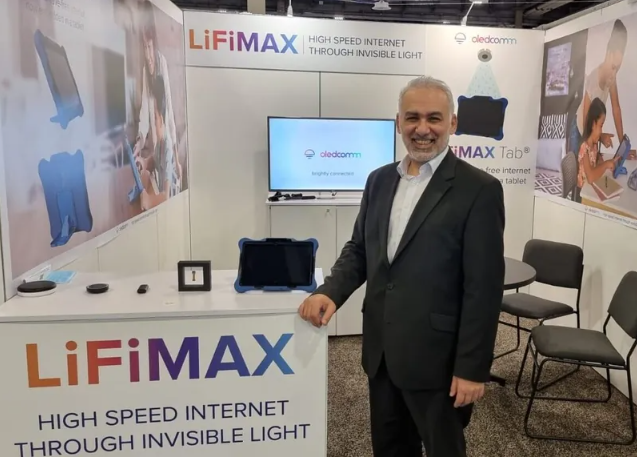LiFi Could Be A Safer Alternative For Those Sensitive to EMF
The Safety of LiFi Technology
In 2011, The European Lighting and Electrotechnical Components Manufacturers' Federation (CELMA) published a research report comparing the photobiological safety of LED and traditional light sources. Their findings indicated that LED lights are as safe as incandescent and fluorescent bulbs for regular use.
The study revealed that LED lights do not emit more blue light than other light sources with the same colour temperature. While acknowledging concerns about excessive blue light exposure, the report emphasised that the blue light component in LEDs is comparable to that of other lighting technologies at equivalent colour temperatures.
CELMA's research concluded that LED lighting is safe when used as intended. The study also addressed optical safety concerns, such as the risks associated with looking directly at intense, point-source lights, and explored potential hazards to eyes and skin. In essence, the report supports the safety of LED lighting while also discussing various aspects of optical safety related to different lighting technologies.
Nevertheless, looking straight into bright, point‐like sources (LEDs, but also other strong point‐like light sources, like clear filament or discharge lamps and including the sun) should be prevented. However, when people happen to look into a bright light source accidentally, a natural protective reflex occurs (people instinctively close their eyes or look away from the source).
Over 12 years later from CELMA report on LED safety and while the initial safety claims are promising, it's crucial to recognise that LiFi is a relatively new technology. As such, there is a need for more comprehensive, long-term and ongoing studies on its potential health impacts. Here are some areas that warrant further investigation:
Long-term exposure effects: Most current studies focus on short-term exposure. Research into the effects of prolonged, daily exposure to LiFi systems is necessary.
Different wavelengths: As LiFi technology evolves, it may use various light wavelengths. Studies should examine the potential impacts of different wavelengths used in LiFi systems.
Interaction with medications and medical conditions: Some individuals may be photosensitive or taking medications that increase light sensitivity. Research should explore how LiFi might affect these populations.
Circadian rhythm impacts: Given that LiFi uses light, studies should investigate any potential effects on human circadian rhythms and sleep patterns.
Comparison with other wireless technologies: Comparative studies between LiFi and other wireless technologies like WiFi and 5G could provide valuable insights into relative health impacts.
Over the past few decades, concerns have been raised about prolonged exposure to RF-EMF from technologies like WiFi and cellular networks, LiFi may offer a lower-EMF alternative. However, it's important to note that light itself is a form of electromagnetic radiation. While visible and near-infrared light are generally considered safe, the unique modulation patterns used in LiFi warrant specific study to ensure there are no unforeseen biological effects.
Benjamin Azoulay from Oledcomm, a leading company at the forefront of LiFi technology, recently stated in a podcast:
"LiFi, of course, it's light, it's as dangerous and as harmless as light can be. Generally speaking, we use frequencies or rather wavelengths that are in the near-infrared. So obviously, all our products have been tested for their photo-biological impact, to make sure there's no impact on health. So yes, yes, it's totally, it's totally safe for use, especially for humans."
Oledcomm and other players in the LiFi industry have repeatedly stated that light signals are proven to have no negative photobiological effects, making them completely safe from a public health perspective.
Image credit to Oledcomm
Potential Benefits for Electrohypersensitive Individuals
An important consideration in the development and adoption of LiFi technology is its potential benefit for people with electrohypersensitivity (EHS). EHS is a condition where individuals report a range of non-specific symptoms that they attribute to exposure to electromagnetic fields.
While the existence of EHS as a medical condition is debated in the scientific community, many people report experiencing symptoms such as headaches, fatigue, stress, sleep disturbances, and skin prickling when exposed to EMF sources like WiFi routers, cell phones, and other wireless devices.
For these individuals, LiFi could offer several potential advantages:
Reduced RF-EMF exposure: Since LiFi uses light waves instead of radio frequencies to transmit data, it could significantly reduce overall exposure to RF-EMF in homes and workplaces.
Controllable light environment: LiFi systems often use visible or near-infrared light, which can be more easily controlled and contained within specific areas compared to radio waves that can penetrate walls.
Option for EMF-sensitive spaces: LiFi can be used to create low-EMF zones in hospitals, schools, or other areas where minimising EMF exposure is desired.
Complementary technology: LiFi could be used alongside or as an alternative to traditional WiFi in areas where electrohypersensitive individuals need to work or live.
It's important to note that while LiFi may offer these potential benefits, more research is needed to fully understand its impact on individuals with EHS. Additionally, as LiFi systems still use a form of electromagnetic radiation (light), some sensitive individuals may still experience symptoms.
As LiFi technology continues to develop, it will be crucial to include electrohypersensitive individuals in studies and trials to better understand how this technology might serve as a more tolerable alternative for radiowave wireless communication like.
Image credit to Oledcomm
Image credit to LiFi Tech News




